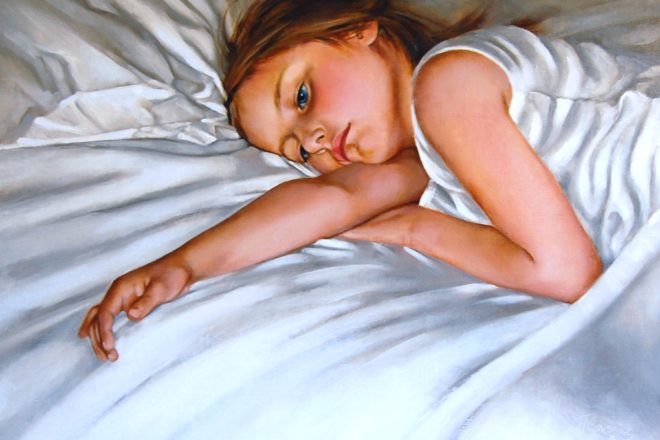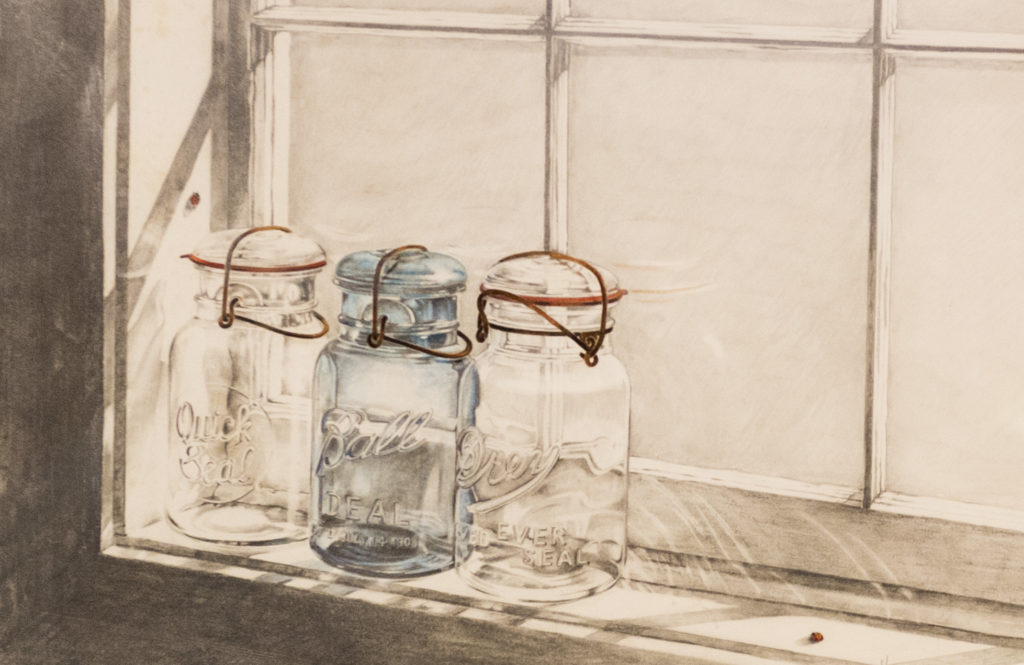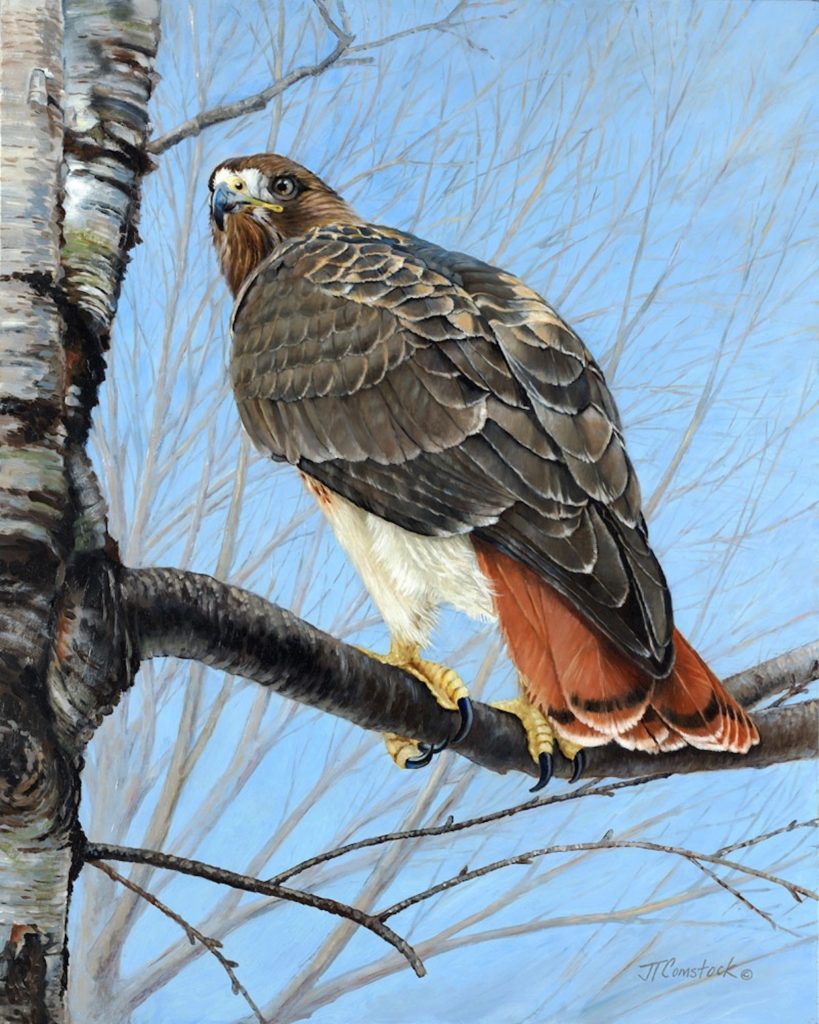In the Eye of the Beholder: Oil painter Jan Comstock
- Share
- Tweet
- Pin
- Share

Jan Comstock stood outside the cage, captivated by the beauty of the magnificent red-tailed hawk that perched within. But as she scanned the enclosure before her — the tether, the lone tree, the untouched piece of raw meat that had been tossed in — she was overcome with sadness and questions.
Was the bird born at the zoo, never having known the freedom it could have had in different circumstances? Was it found injured and then rehabbed, protected from a world it couldn’t survive in? Or was it trapped for display, sentenced to a life behind bars for the entertainment of zoo-goers?
The answer didn’t matter because when Comstock returned home, she set the bird free the only way she knew how: with oil paints and canvas.
Bare branches and a blue sky replaced the cold, metal cage. The red-tail stands not on a short piece of familiar wood, but on a thick branch of a peeling birch tree, a temporary rest stop while it waits intently for its next unsuspecting prey.
In a Baileys Harbor studio, the bird was free at last.
That level of emotional commitment to subject is standard for this lifelong artist, whether she’s recreating a familiar Door County landscape, rendering wildlife in oils, or capturing an individual’s personality in a timeless portrait.
“I only paint things that move me in some way,” Comstock said.
She has always been attracted to emotionally expressive works, recalling her fascination with the creative output of prolific American artist Norman Rockwell. His cover illustrations for the Saturday Evening Post were idealistic and sentimental portrayals of mid-20th century American life, and while considered overly sweet by art critics of the time, they resonated with Comstock.
She references his 1943 oil painting “Freedom from Want” depicting a family gathered at a table for a holiday meal.
“I came from a very close-knit family,” she said. “The kids were very much a part of this family. We ate together. We worked together…my mother and father had sisters and brothers. They always came over. The holidays were always huge. Christmas, my mother had 12 brothers and sisters. You visited every one of those houses during Christmas season. That’s what he was painting about.”
For Comstock, art and family have always been intertwined. She recalls childhood memories of her mother telling stories and sketching scenes to accompany them. Comstock marks this as the time when the budding artist within her began to blossom.
“Neither of my sisters ever remember her drawing,” Comstock said. “They remember her telling stories. All I can remember is her drawing.”
It wasn’t long before that skill for visual storytelling became apparent in Comstock. High school reports were always accompanied by artwork, and during hometown festivals and holiday celebrations in Antigo, Wisconsin, she joined classmates in painting downtown business windows to celebrate the festivities.
Life since has been a dedication to the arts in one form or another. As a freelance graphic artist and designer for nearly four decades, she has designed advertisements, logos, billboards and, with her husband Rob, hand-carved signs for restaurants, inns and other businesses.
When she and Rob relocated from Marshfield, Wisconsin to Baileys Harbor in the late ‘90s, they brought their award-winning Sign Wizards business with them, crafting a number of signs that still usher visitors into Door County businesses today, like the White Lace Inn in Sturgeon Bay.
It wasn’t long before Comstock began exploring opportunities to connect the arts to the community, landing first at the Peninsula School of Art and then becoming executive director of The Hardy Gallery in Ephraim.
Under her guidance, the gallery’s focus on enhancing the creative enrichment of local youth and introducing local artists to the community blossomed. She was instrumental in starting Art Camp, a segment of Gibraltar Schools’ long-running Migrant Education Program benefiting the underprivileged children of migrant workers.
“That was just a joy to see the experience those kids had with just a couple weeks of art,” Comstock said.

“Two Ladies” by Jan Comstock, a giclée print of fruit canning jars that were passed down to Comstock from her mother.
Though Art Camp ended in 2015, a second program Comstock helped start toward the end of her tenure is still going strong. The Exposure to Creativity program connects Gibraltar High School students with creative professionals in the community through hands-on creative workshops.
Everything she did, she explained, was motivated by the vision of the late Francis Hardy, the painter and summertime Ephraim resident who strove to create a climate of understanding and appreciation of the arts in Door County. Her dedication to his vision did not go unnoticed by patrons, board members and volunteers, like local gallery owner Tom Seagard.
“Jan went out of her way to make exhibition of any level of art positive,” Seagard said. “She really supported and does support the fellow artists that she encounters.”
But with that dedication came sacrifice. She had little time to continue her own artwork and in 2008, decided it was “time to do the artwork.” She retired from her position as executive director. A year later, she was back — this time, as an artist in The Hardy’s Collector’s Choice Invitational.
Her experience operating the gallery proved invaluable in shaping her current artistic philosophy. Where she once saw value in the artist’s statements that explain and accompany exhibit artwork, she now sees them as a barrier to connecting the viewer on an emotional level. While she still writes short descriptions of her work, she shies away from giving every detail of the where and why.
“It’s the viewer’s interpretation of relating to something in their life that is the important thing,” she said.
In her lifetime, Comstock has created countless paintings with the goal of evoking an emotional response from viewers. Today, there is one she references as the ultimate achievement of this: “The Dreamer.”
A young girl rests on a bed in sheets of white, her eyes open, her face holding the seriousness of deep thought. It was a re-creation of her granddaughter waking up, “a dreamy little kid.” But for former Door County Living writer Sally Slattery, who saw it on display in the Miller Art Museum’s 35th Juried Annual exhibition in 2010, it sparked something different.
In 2013, Slattery’s fiction story, “Telling Isabella” appeared in the magazine. In it, a young adult woman struggles with how to tell her six-year-old niece that her grandfather has died.
The image of “The Dreamer” captured that precious moment before reality intercepts another small piece of youthful innocence.
“It just seemed like it was something that had happened in her life,” Comstock said. “It wasn’t this happy little scene. It was something that really emotionally connected with her from her childhood. Art is in the eye of the beholder.”


